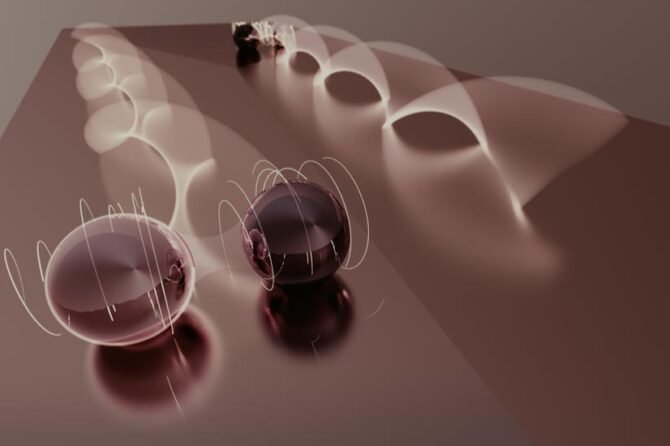Scientists from EPFL, MIT, and CEA Saclay demonstrate a state of vibration that exists simultaneously at two different times. They evidence this quantum superposition by measuring the strongest class of quantum correlations between light beams that interact with the vibration.
An especially counter-intuitive feature of quantum mechanics is that a single event can exist in a state of superposition – happening both here and there, or both today and tomorrow.
Such superpositions are hard to create, as they are destroyed if any kind of information about the place and time of the event leaks into the surrounding – and even if nobody actually records this information. But when superpositions do occur, they lead to observations that are very different from that of classical physics, questioning down to our very understanding of space and time.
The researchers used a very short laser-pulse to trigger a specific pattern of vibration inside a diamond crystal. Each pair of neighboring atoms oscillated like two masses linked by a spring, and this oscillation was synchronous across the entire illuminated region. To conserve energy during this process, a light of a new color is emitted, shifted toward the red of the spectrum.
This classical picture, however, is inconsistent with the experiments. Instead, both light and vibration should be described as particles, or quanta: light energy is quantized into discrete photons while vibrational energy is quantized into discrete phonons(named after the ancient Greek “photo = light” and “phono = sound”).
The process described above should therefore be seen as the fission of an incoming photon from the laser into a pair of photon and phonon – akin to nuclear fission of an atom into two smaller pieces.
But it is not the only shortcoming of classical physics. In quantum mechanics, particles can exist in a superposition state, like the famous Schrödinger cat being alive and dead at the same time.
Even more counterintuitive: two particles can become entangled, losing their individuality. The only information that can be collected about them concerns their common correlations. Because both particles are described by a common state (the wavefunction), these correlations are stronger than what is possible in classical physics. It can be demonstrated by performing appropriate measurements on the two particles. If the results violate a classical limit, one can be sure they were entangled.
In the new study, EPFL researchers managed to entangle the photon and the phonon (i.e., light and vibration) produced in the fission of an incoming laser photon inside the crystal. To do so, the scientists designed an experiment in which the photon-phonon pair could be created at two different instants. Classically, it would result in a situation where the pair is created at time t1 with 50% probability, or at a later time t2 with 50% probability.
But here comes the “trick” played by the researchers to generate an entangled state. By a precise arrangement of the experiment, they ensured that not even the faintest trace of the light-vibration pair creation time (t1 vs. t2) was left in the universe. In other words, they erased information about t1 and t2. Quantum mechanics then predicts that the phonon-photon pair becomes entangled, and exists in a superposition of time t1 and t2. This prediction was beautifully confirmed by the measurements, which yielded results incompatible with the classical probabilistic theory.
By showing entanglement between light and vibration in a crystal that one could hold in their finger during the experiment, the new study creates a bridge between our daily experience and the fascinating realm of quantum mechanics. (EPFL)
The paper has been published in ScienceAdvances.
The post A state of vibration that exists simultaneously at two different times appeared first on Swiss Quantum Hub.



